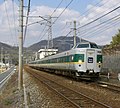381 series
| 381 series | |
|---|---|
 A 381 series on a Mahoroba service in May 2010 | |
| In service | 1973–June 2024 (regular service) |
| Manufacturer | Hitachi, Kawasaki Heavy Industries, Kinki Sharyo |
| Replaced | 183 series |
| Constructed | 1973–1982 |
| Entered service | 1973 |
| Refurbished | 1997–2011 (JR West) |
| Number built | 277 vehicles |
| Number in service | None |
| Number preserved | 2 vehicles |
| Number scrapped | 140 vehicles |
| Successor | 383 series, 287 series, 289 series, 273 series |
| Formation | 3/4/6/7/9 cars per trainset |
| Operators | JNR (1973–1987) JR Central (1987–2008) JR West (1987–2024) |
| Depots | Hineno, Goto, Fukuchiyama |
| Lines served | Various |
| Specifications | |
| Car body construction | Aluminium alloy |
| Car length | 21,300 mm (69 ft 11 in) |
| Width | 2,920 mm (9 ft 7 in) |
| Height | 3,383 mm (11 ft 1.2 in) |
| Maximum speed | 120 km/h (75 mph) |
| Traction system | Resistor control |
| Electric system(s) | 1,500 V DC overhead lines |
| Current collector(s) | Pantograph |
| Track gauge | 1,067 mm (3 ft 6 in) |
The 381 series (381系, 381-kei) was a tilting DC electric multiple unit (EMU) train type introduced in 1973 by Japanese National Railways (JNR), and operated by West Japan Railway Company (JR-West), and Central Japan Railway Company (JR Central) in Japan.[1]
Fleet[edit]
As of 1 April 2023[update], 62 vehicles were operated by JR-West.[2][unreliable source?]
Operations[edit]
JR Central[edit]
- Shinano (1973–May 2008)
JR-West[edit]
- Kuroshio (from October 1978 until 30 October 2015[3])
- Yakumo (from July 1982 until 15 June 2024[4])
- Kounotori (until 31 May 2011,[5] from 1 June 2012[6] until 30 October 2015[7])
- Kinosaki (from 1 June 2012[6] until 30 October 2015[7])
- Hashidate (from 16 March 2013 until 30 October 2015[7])
- Hanwa Liner rapid service (until March 2011)
- Yamatoji Liner rapid service (until March 2011)
Livery variations[edit]
-
JNR Livery (JR Central Shinano set), July 2006
-
JR-West Kuroshio refurbished set
-
381 series Super Kuroshio set, 1992
-
381 series Super Kuroshio KuRo 380 refurbished car
-
JR-West Yakumo set, July 2007
-
JR-West set in Super Yakumo livery, September 2007
-
JR-West set in Yuttari Yakumo livery, July 2023
History[edit]
The 381 series EMU was developed from the experimental 591 series 3-car articulated tilting EMU tested from 1970.[8]
Trainsets entered revenue service from 10 July 1973 on the Shinano limited express between Nagoya and Nagano.[8]
JR-West 381 series trains were removed from Kuroshio, Kounotori, Kinosaki, and Hashidate limited express services in October 2015, with the last services operating on 30 October.[7]
As the new 273 series sets began service from 6 April 2024, it was announced by JR West in December 2023 that the remaining 381 series sets were scheduled to be retired from June 2024.[9] The next sets to be retired were those repainted in various historic liveries; the sets sporting the Yuttari Yakumo livery were scheduled for retirement at a later date.[10] The last regularly scheduled Yakumo run by this series took place on 15 June 2024 thus marking the end of regular service of the 381 series as a whole.[4]
Preserved examples[edit]
- KuHa 381-1: (built 1973 by Kawasaki Heavy Industries) SCMaglev and Railway Park, Nagoya.[11]
- KuRo 381-11: (built 1974 by Kawasaki Heavy Industries) formerly at the SCMaglev and Railway Park, Nagoya,[11] removed in June 2019.[12]
- KuRo 381-1104: (built 1978 by Kawasaki Heavy Industries) Suita Depot, Osaka.
-
Preserved KuHa 381-1 at the SCMaglev and Railway Park, April 2011
-
KuRo 381 at the SCMaglev and Railway Park, March 2016
-
KuRo 381-1104 in May 2019
Notes[edit]
References[edit]
- ^ Jēāru zensharyō handobukku: Rail Magazine 2009 JR全車輌ハンドブック2009 [JR Rolling Stock Handbook 2009] (in Japanese). Japan: Neko Publishing. 2009. ISBN 978-4-7770-0836-0.
- ^ "JNR 381 series - The Red List of Trains in Japan". bateman.monologue.jp. Retrieved 31 May 2023.
- ^ くろしお381系引退へ…パンダシートも見納め [Kuroshio 381 series to be withdrawn – Also end of panda seats]. Yomiuri Online (in Japanese). Japan: The Yomiuri Shimbun. 29 October 2015. Archived from the original on 24 October 2015. Retrieved 29 October 2015.
- ^ a b "「国鉄特急型電車」定期運用は終焉へ 381系約50年の生涯を振り返る!" [Regular service of the "Japanese National Railways Limited Express train" comes to an end - looking back at the 50-year life of the 381 series!]. RM News (in Japanese). Japan: Neko Publishing. 15 June 2024. Retrieved 16 June 2024.
- ^ "新型車両(287 系)追加投入の詳細" [Details of further introduction of new (287 series) trains] (PDF). JR-West news release (in Japanese). West Japan Railway Company. 28 April 2011. Archived from the original (PDF) on 27 September 2011. Retrieved 2 May 2011.
- ^ a b "JR西日本 381系福知山車FE編成が営業運転開始" [JR-West: Fukichiyama-based 381 series FE sets enter service]. Tetsudō Daiya Jōhō Magazine. 41 (340): 75. August 2012.
- ^ a b c d 381系が関西地区の定期運用から離脱 [381 series removed from scheduled Kansai area services]. Japan Railfan Magazine Online (in Japanese). Japan: Koyusha Co., Ltd. 31 October 2015. Retrieved 1 November 2015.
- ^ a b プロトタイプの世界 – Prototype World. Japan: Kōtsū Shimbunsha. December 2005. pp. 12–19. OCLC 170056962.
- ^ "381系「リバイバル塗装車両」6月までに運転を終了" [Remaining 381 series to be retired by June 2024]. Japan Railfan Magazine Online (in Japanese). 16 December 2023. Retrieved 19 December 2023.
- ^ "381 系特急やくも「リバイバル塗装車両」の今後の運行計画について" [Regarding the decommissioning of the 381 series limited express Yakumo sets featuring “revival liveries”] (PDF). westjr.co.jp (in Japanese). 15 December 2023. Retrieved 10 February 2024.
- ^ a b "「リニア・鉄道館」ファーストガイド" ["SCMaglev and Railway Park" First Guide]. Tetsudō Daiya Jōhō Magazine. 40 (324): 20–33. April 2011.
- ^ リニア・鉄道館 N700系車両の展示について [N700 series shinkansen exhibit at SCMaglev and Railway Park] (PDF). News release (in Japanese). Japan: Central Japan Railway Company. 17 May 2019. Retrieved 14 July 2019.












